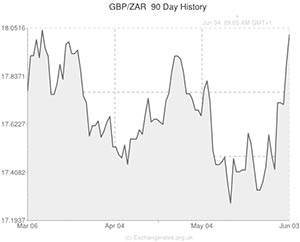
Wednesday saw the Rand trading in a narrow range against the Pound and close to a 10 week low against the US Dollar.
The Rand came off some of its recent lows but remained in a softer position overall as a result of lacklustre domestic news.
Today’s HSBC PMI for South Africa revealed that operating conditions deteriorated for a second month as output and new orders declined further.
However, the report also detailed the maintenance of modest employment growth as well as an easing in input and output price inflation.
The measure of operating conditions for South Africa’s private sector rose slightly from 49.4 in April to 49.7 in May, but remained below the 50 mark separating growth from contraction.
HSBC economist David Faulkner said of the report; ‘Following last week’s figures, which showed GDP shrunk in the first quarter of the year, the HSBC South Africa PMI continues to show the fragility of the local economy, with a second successive month of contracting private sector activity.’
Faulkner added; ‘The protracted strike in the platinum sector weighed on the economy’s performance in May and remains a major factor in restraining demand, with output and new orders below 50 for a third consecutive month. While the pace of contraction eased slightly, and new export orders were unchanged, it is apparent that demand will remain stifled without resolution to the mining strike.’
On Tuesday the Rand came under notable pressure as investors considered the recent run of downbeat South African reports, including last week’s below forecast GDP data.
The emerging-market asset hit a 10-week low against the US Dollar and slumped to a low of 18.1010 against the Pound.
The GBP/ZAR exchange rate was little-changed on Wednesday despite the release of a worse-than-forecast shop price report for the UK.
While economists had expected the British Retail Consortium’s shop price measure to slide by 1.3 per cent year-on-year, it actually showed an annual decline of 1.4 per cent.
The price falls were largely due to discounts in DIY goods, clothing and footwear.
However, a representative from the British Retail Consortium asserted that he foresees a surge in consumer demand over the next few months as shoppers take advantage of competitive prices.
Separate UK data showed that the nation’s service sector grew at a slightly slower pace in May.
The PMI measure slipped from 58.7 to 58.6 in May – moderately better than the decline to 58.2 envisaged.
Tomorrow fluctuations in the GBP/ZAR pairing are most likely to occur as a result of the Bank of England’s interest rate decision.
If the central bank delivers a surprise-free decision the Pound may continue trading at its current levels.
However, any unexpected developments could have a considerable impact on Sterling.
Friday’s UK trade balance and South Africa’s foreign exchange reserves reports may cause more GBP/ZAR volatility before the weekend.
South African Rand (ZAR) Exchange Rates
[table width=”100%” colwidth=”50|50|50|50|50″ colalign=”left|left|left|left|left”]
Currency, ,Currency,Rate ,
Pound Sterling, ,South African Rand,18.0238,
,South African Rand,18.0238,
Euro, ,South African Rand,14.6333,
,South African Rand,14.6333,
US Dollar, ,South African Rand,10.7505,
,South African Rand,10.7505,
Australian Dollar, ,South African Rand,10.0025,
,South African Rand,10.0025,
New Zealand Dollar, ,South African Rand,9.0454,
,South African Rand,9.0454,
Canadian Dollar, ,South African Rand,9.7838,
,South African Rand,9.7838,
[/table]

Comments are closed.